This post may contain affiliate links. Please read our disclosure policy.
Rich and flavorful, easy brown gravy made with beef or chicken stock (with or without drippings) and thickened with a flour roux – ready to enjoy in about 10 minutes for mashed potatoes, roast dinners, Thanksgiving, and Christmas!
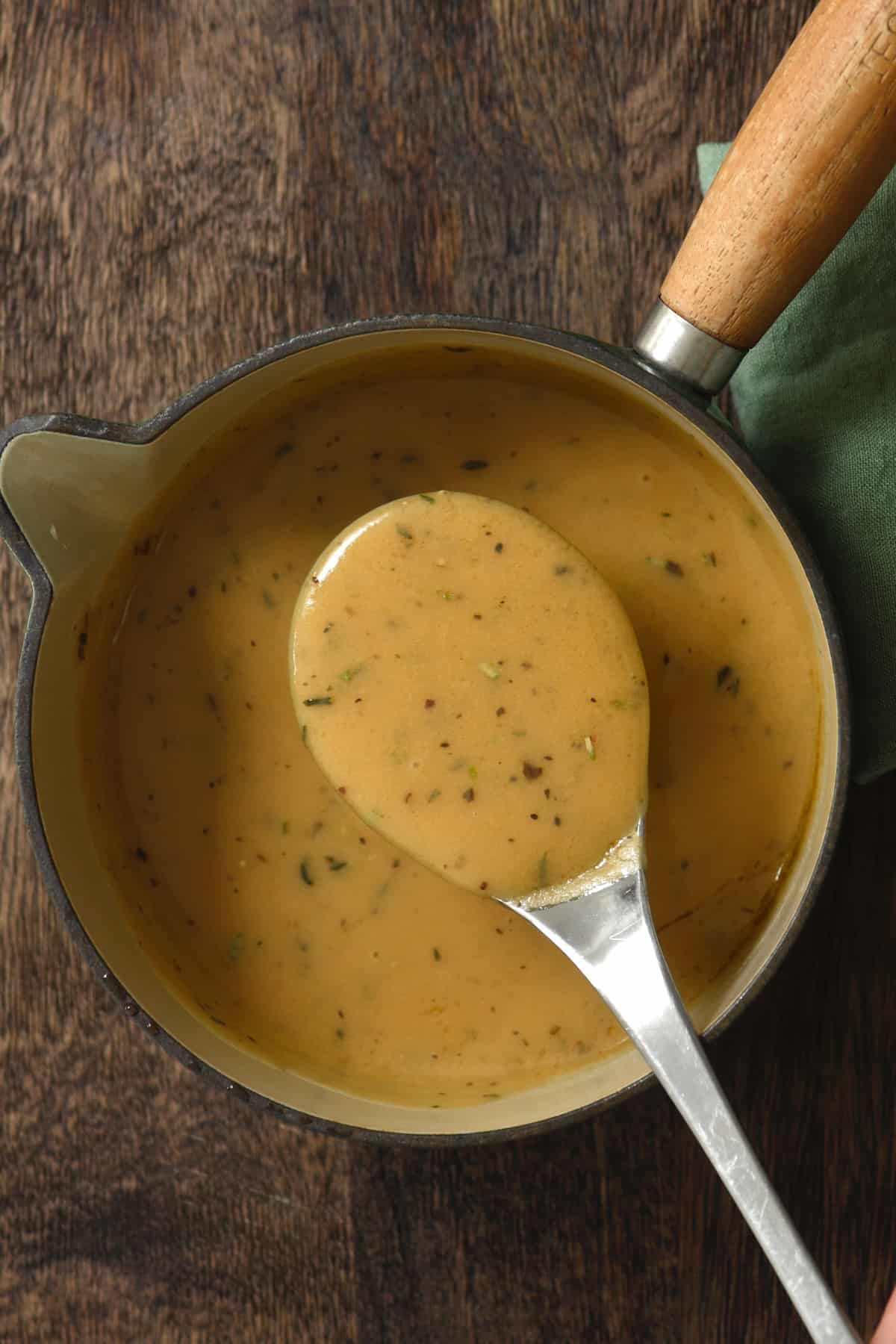
For years, I clung to my tub of gravy granules, incorrectly assuming that making brown gravy from scratch would be a long, laborious process. I couldn’t have been more wrong, though, as this easy brown gravy recipe from scratch is not only super simple to prepare, but takes just 10 minutes and tastes so much better than packaged products!
You can even make this brown without drippings using chicken or beef broth, depending on what you plan to serve it with. Either way, this is the perfect fuss-free homemade brown gravy to serve on busy mid-week evenings and during the holidays!
Prefer a thinner beef sauce? Check out my au jus recipe (with or without drippings). Prefer something 100% meat free? Head on over to my easy vegan brown gravy or white gravy recipe.
What’s in This Post
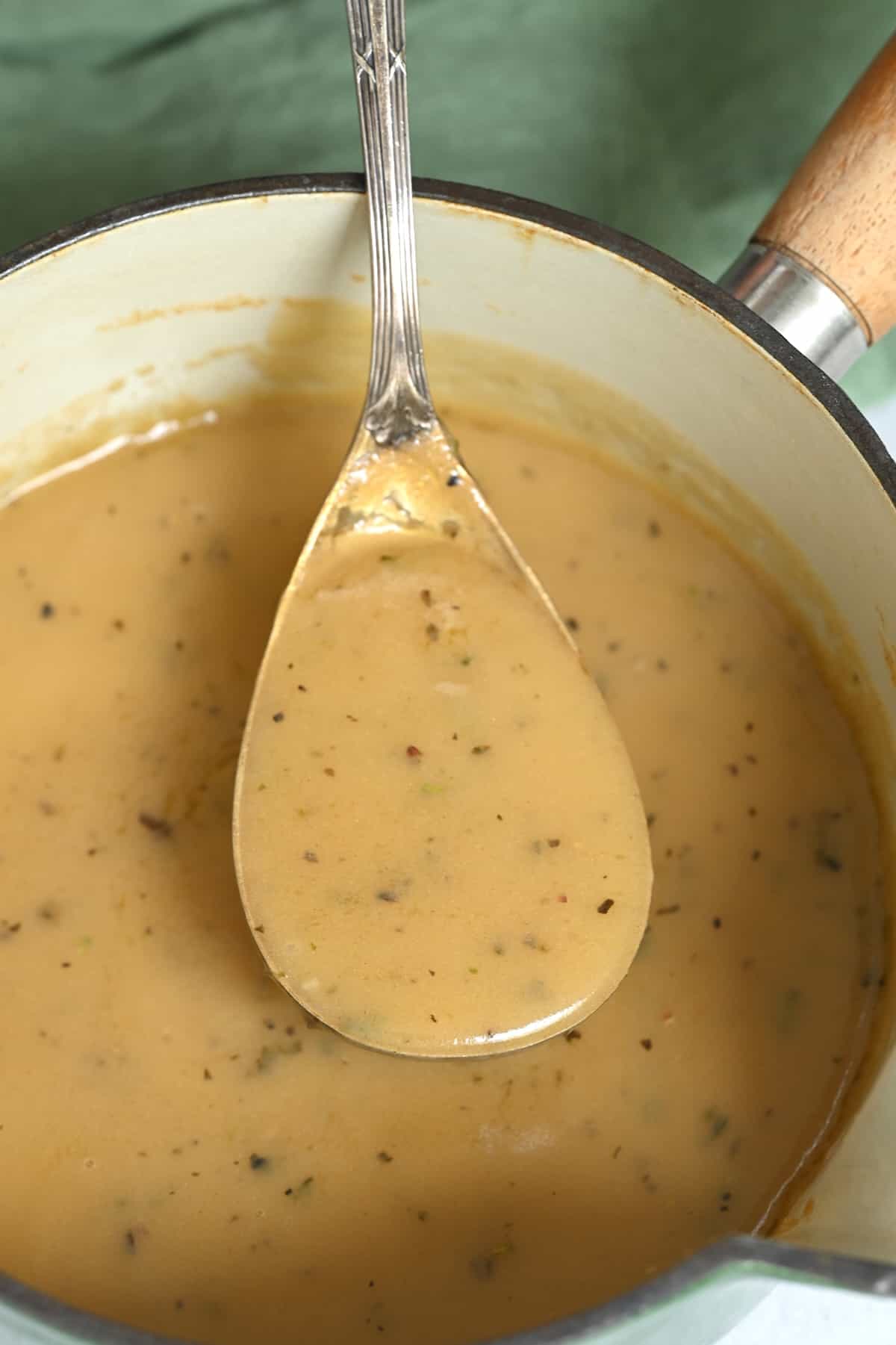
What Is Brown Gravy
Gravy is a sauce made with stock and/or the juices (drippings) from cooked meat that run naturally during the process. That is popularly combined with several herbs and seasonings, then thickened with either flour roux or cornstarch, though traditionally the former.
Brown gravy, specifically, is a gravy made with the drippings (or stock) from roasted meat or poultry, like beef or chicken, and is often, though not always, cooked with onions.
For this recipe, however, I’ve stuck to the basics with a careful selection of several aromatic spices and dried herbs. They pair well with homemade chicken gravy or a beef gravy recipe. Perfect for enjoying over mashed potatoes, roasted meat, and veggies. You can even freeze the leftovers for another time!
What You Need for Brown Gravy
Get back to the basics with this aromatic, savory, delicious homemade brown gravy mix made with simple pantry ingredients and no dripping required (but optional, if preferred).
- Broth: For this brown gravy recipe, you can use store-bought or homemade chicken stock or beef stock (or a combination of the two). Liquid is best, but you can use stock tablets/pots in a pinch. I use low-sodium broth to control the sodium levels.
- For the roux: You’ll need unsalted butter and all-purpose flour (or an all-purpose gluten-free flour blend) in equal parts.
- Worcestershire sauce: This adds a tangy, umami-rich depth to the gravy.
- Seasonings: There are several spices needed to prepare chicken or beef gravy from broth, most of which are likely in your pantry already.
- Garlic powder
- Onion powder
- Salt – add to taste as the stock may be salty enough already. Use low-sodium soy sauce for added umami flavor.
- Black pepper
- Herbs: This beef or chicken gravy recipe uses a fairly typical combination of dried herbs for an aromatic sauce.
- Rosemary
- Thyme
- Basil – dried sage would work well in its place.
- Drippings: (Optional) I’ve specifically written this recipe, so you have an option for delicious gravy when you don’t have pan drippings. However, if you’ve got a roast in the oven, feel free to use the drippings in place of some of the broth. The drippings are all the juices that accumulate in the pan when roasting meats like beef, chicken, turkey, pork, etc.
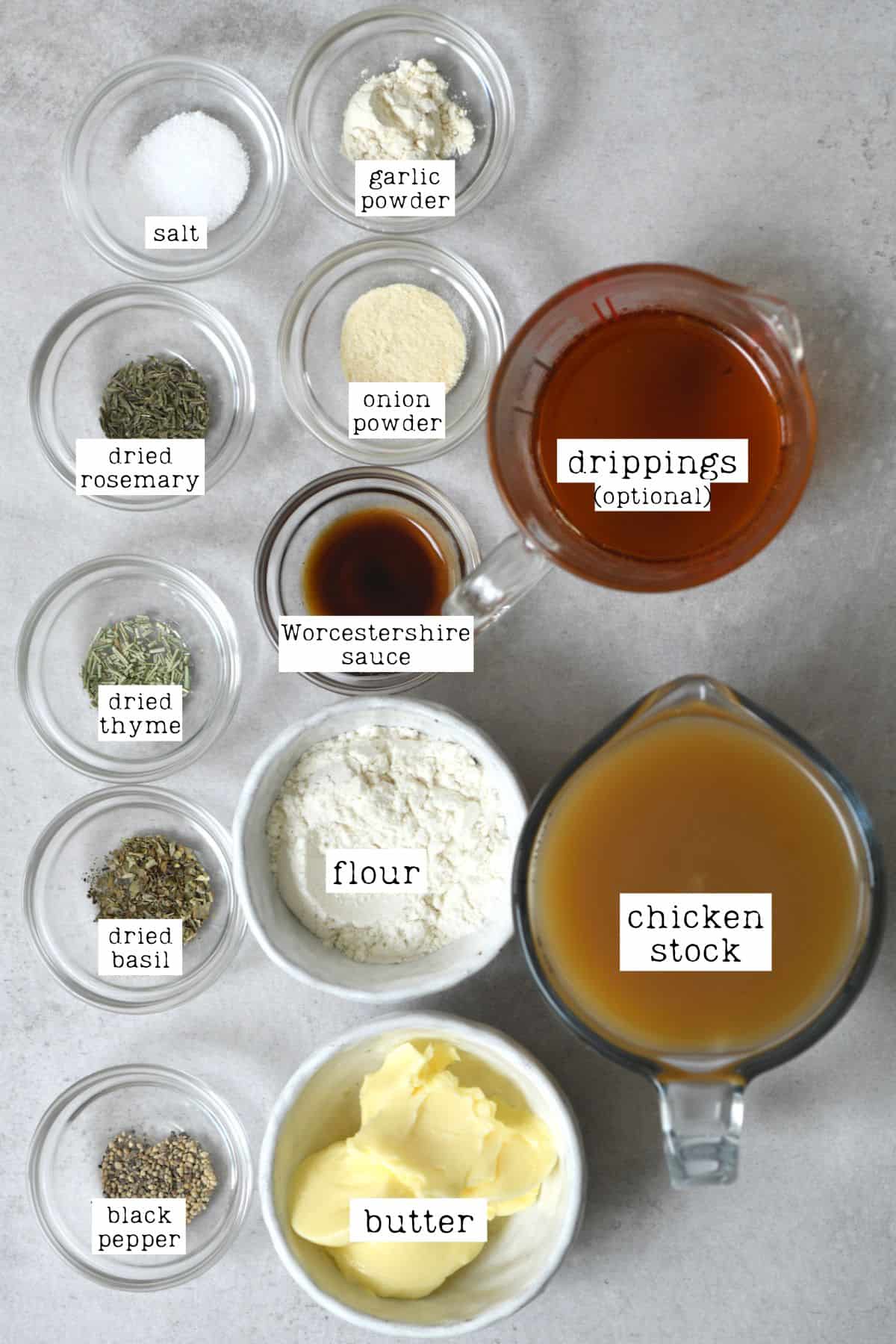
Making Brown Gravy With Roux Vs Corn Starch
Instead of flour roux, you could use naturally gluten-free cornstarch to thicken the gravy.
To do so, make a cornstarch slurry combining 1:1 starch and cold water (start with 1 Tbsp and add more if needed) into a smooth paste/liquid in a small bowl. Pour that into the pan at the end of the cooking process, increase to medium heat, stirring constantly until thickened.
If using cornstarch, I highly recommend stirring a pat of cold butter into the sauce right at the end and stirring until it melts into the sauce. This will add extra richness you lose from omitting the butter in the roux.
How To Make Brown Gravy Without Drippings
First, melt the butter in a saucepan over medium-low heat, being careful not to allow it to brown.
Then, add the flour, whisking well to ensure there are no lumps. Cook it for 2-3 minutes, until it browns, then reduce the heat to low.
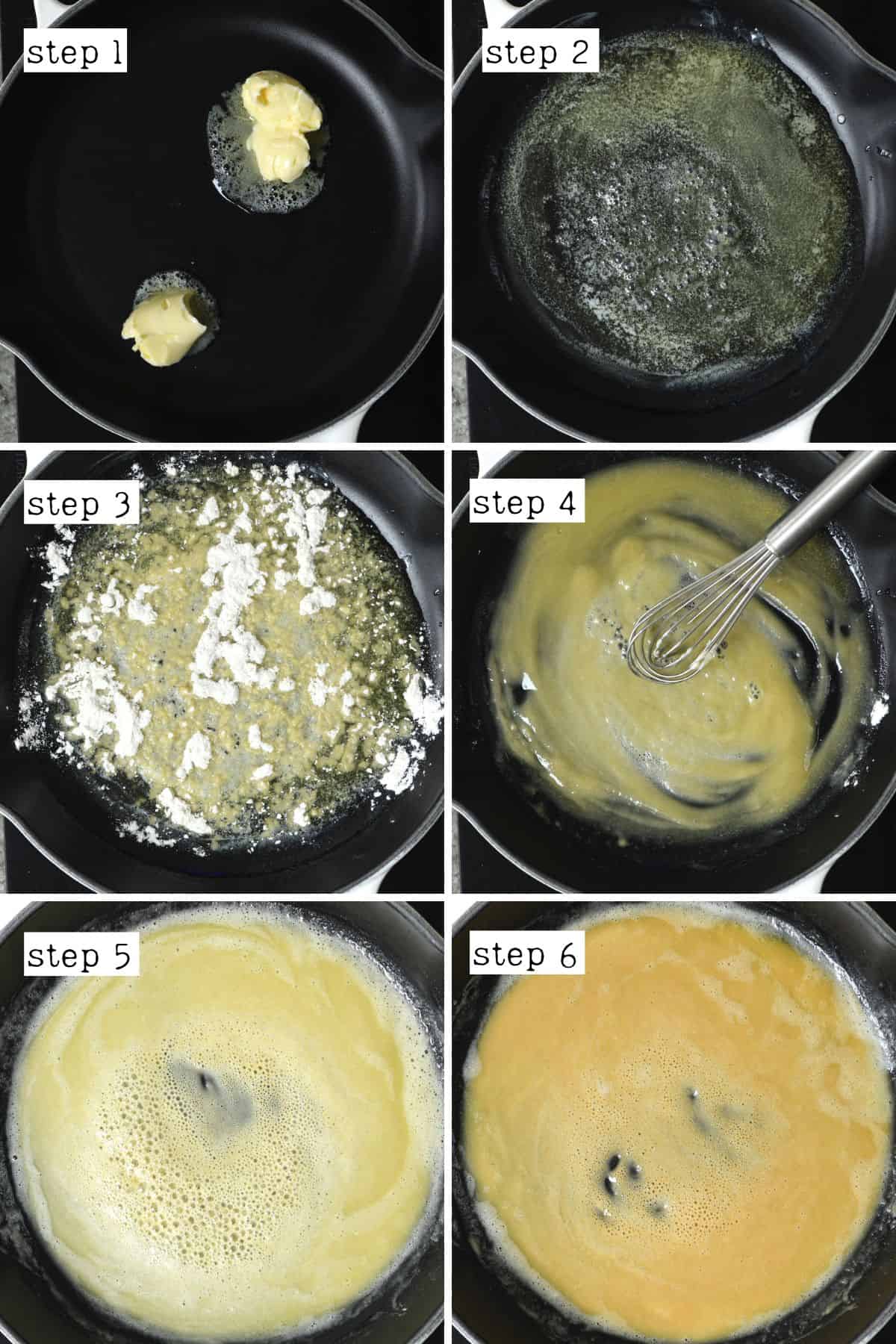
Then, pour in the chicken stock (or beef stock) a small amount at a time, whisking constantly to ensure the roux remains smooth and lump-free. Allow the sauce to thicken slightly after each addition, then add more until you’ve used it all.
If you want to use the meat drippings, add them now in place of some of the broth, and stir well.
Next, add the Worcestershire sauce, whisking well. Then stir in the dried herbs and any salt if needed. Finally, add the garlic powder, onion powder, and black pepper and whisk well (adjust the amounts to taste).
Allow the sauce to simmer for a few more minutes to thicken and reduce. Then remove the pot from the heat and enjoy!
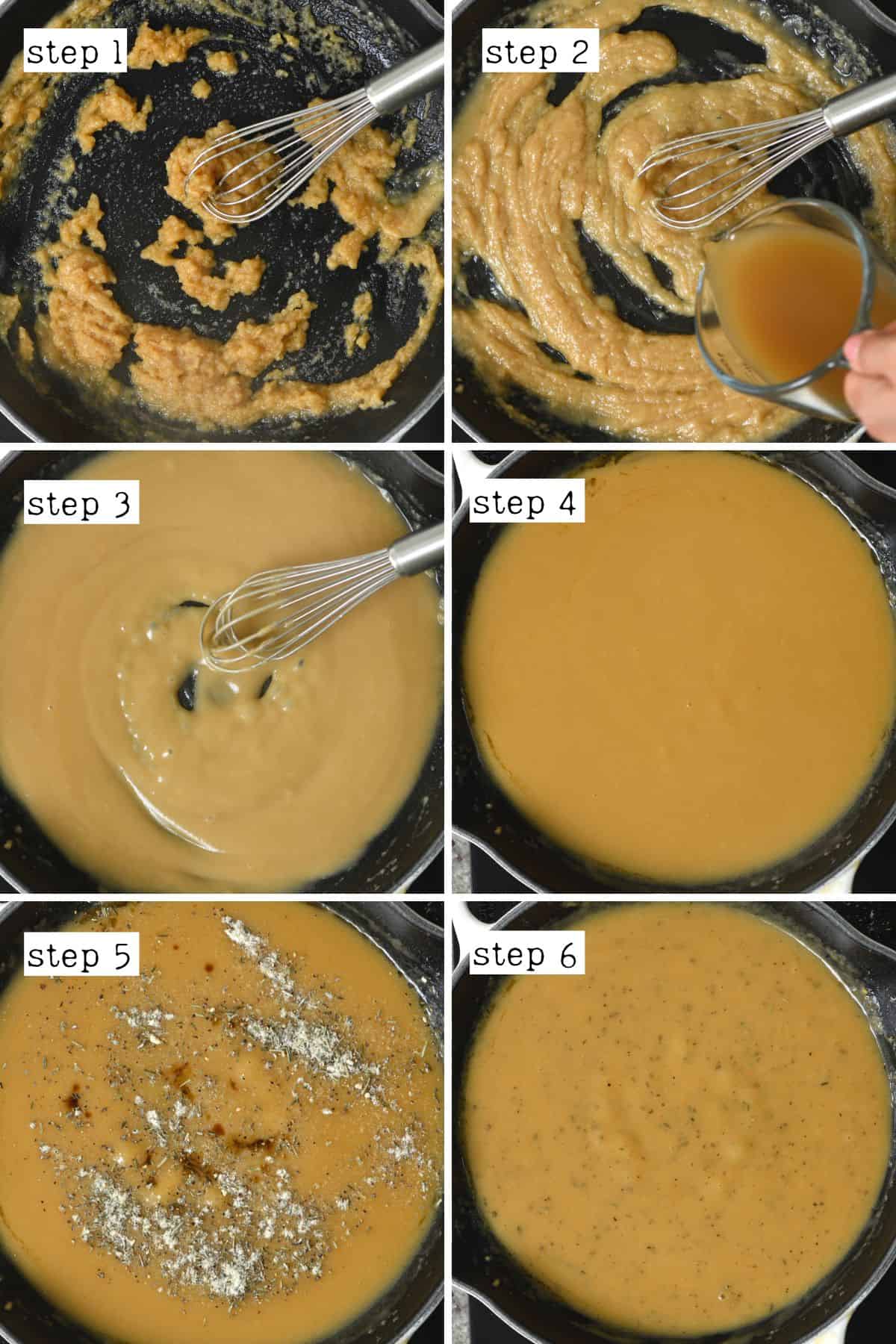
Make Ahead Brown Gravy
Brown gravy recipes can be stored in an airtight container in the fridge for 3-4 days making it a great option for preparing ahead of time.
How Do I Reheat Brown Gravy
Use a microwave or stovetop, whisking well until smooth and heated through. You may need an extra splash of water or stock to bring it back to the correct consistency.
Can You Freeze Gravy
You can freeze the beef gravy/sauce in an airtight container, ice cube tray, or Ziplock bag in the freezer for up to 6 months. However, I recommend using it within 3-4 months for the best flavor.
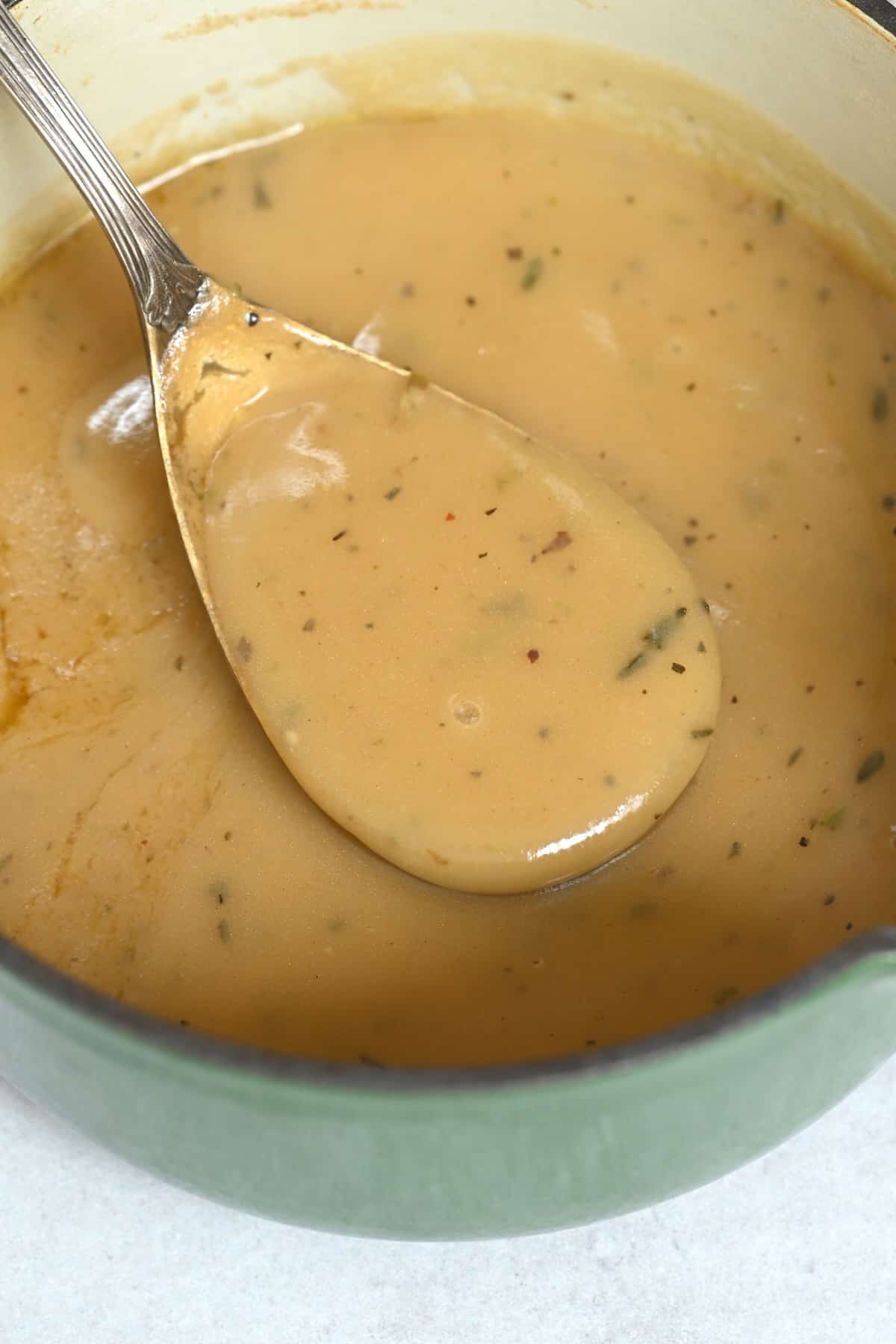
What To Serve With Brown Gravy
This homemade brown gravy (whether you choose to make chicken gravy or beef gravy) is packed with flavor and super versatile, perfect for enjoying with a roast dinner, Thanksgiving, Christmas, and with:
- Roasted meat – swap out the broth based on the dish (i.e., chicken broth for roast chicken, beef broth gravy for roast beef, etc.).
- Over mashed potatoes – this is the best gravy for mashed potatoes. It’s like they’re made for one another!
- Roasted potatoes or baked potatoes.
- Cooked veggies (cauliflower and brocolli, carrots, asparagus, green beans, Brussels sprouts, etc.).
- Stuffed butternut squash.
- Over meatballs and meatloaf.
- With buttermilk biscuits and rolls.
- Use it in casseroles.
- With pies – including pastry pies (beef or chicken gravy), Shepherd’s pie (using homemade beef gravy recipes), etc.
- For poutine and to dip french fries.
- Mix it into mayonnaise to make a holiday spread.
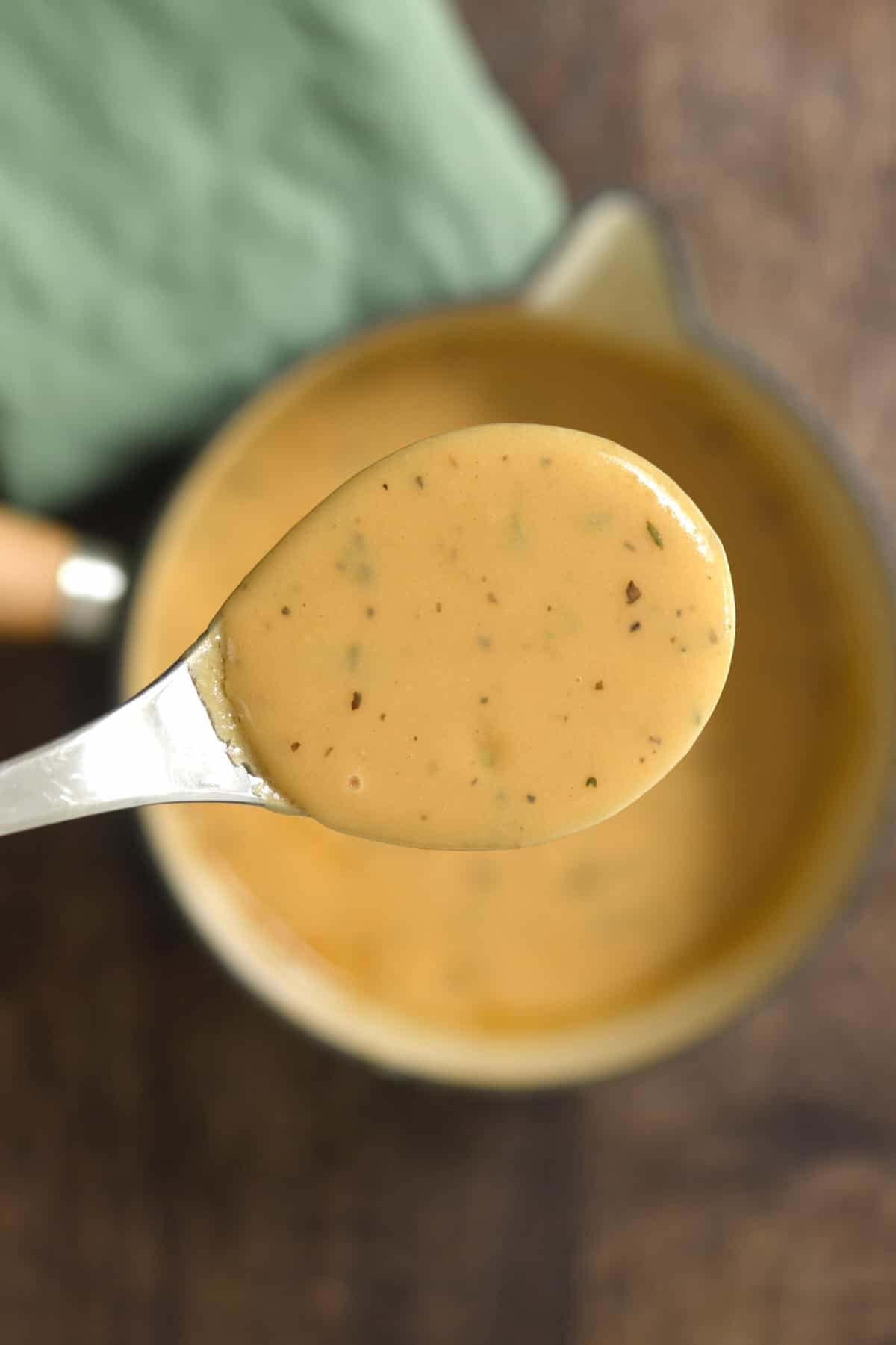
FAQs and Troubleshooting
Both will work fine for thickening homemade brown gravy. However, I prefer a butter roux as it produces a richer, more velvety, luscious gravy.
If you want a thinner gravy from the get-go, I recommend using less flour in the roux. However, you can thin it with additional stock/broth or water if you’ve already made it.
If the gravy is too thin, add more roux or cornstarch. Make a slurry by combining the flour/starch with a small amount of warm liquid into a smooth paste (i.e., 1 tablespoon flour/starch to 1-2 tbsp water). Then transfer that to the pan and increase the heat, stirring constantly, until thickened.
Whisk it! But seriously, the key to avoiding lumpy brown gravy is to add a tiny amount of stock to the roux at a time, whisking vigorously until smooth. Then, repeat until you’ve used all the remaining stock, and the gravy is smooth and lump-free.
Even if you do everything right, sometimes you may still end up with lumpy gravy. But don’t fear, as there are several fixes.
Whisking: Vigorously whisking, pressing any lumps into the side of the bowl/pan, and really giving it a good mixing can help to break up the bigger flour lumps.
Straining: Simply pour the brown grain through a strainer before serving. However, this only works if you’re making a smooth gravy (i.e., no onions, etc.).
Blending: Carefully transfer the gravy to a food processor or blender and blend until smooth. Hold down the lid with a tea towel, and be careful as the liquid is hot.
More Homemade Sauce Recipes
- Buffalo Wing Sauce Recipe
- Alabama White BBQ Sauce
- Quick and Easy Pizza Sauce
- Homemade White Gravy
- Vegan bechamel sauce (white sauce)
- Quick and No-Fail Hollandaise Sauce
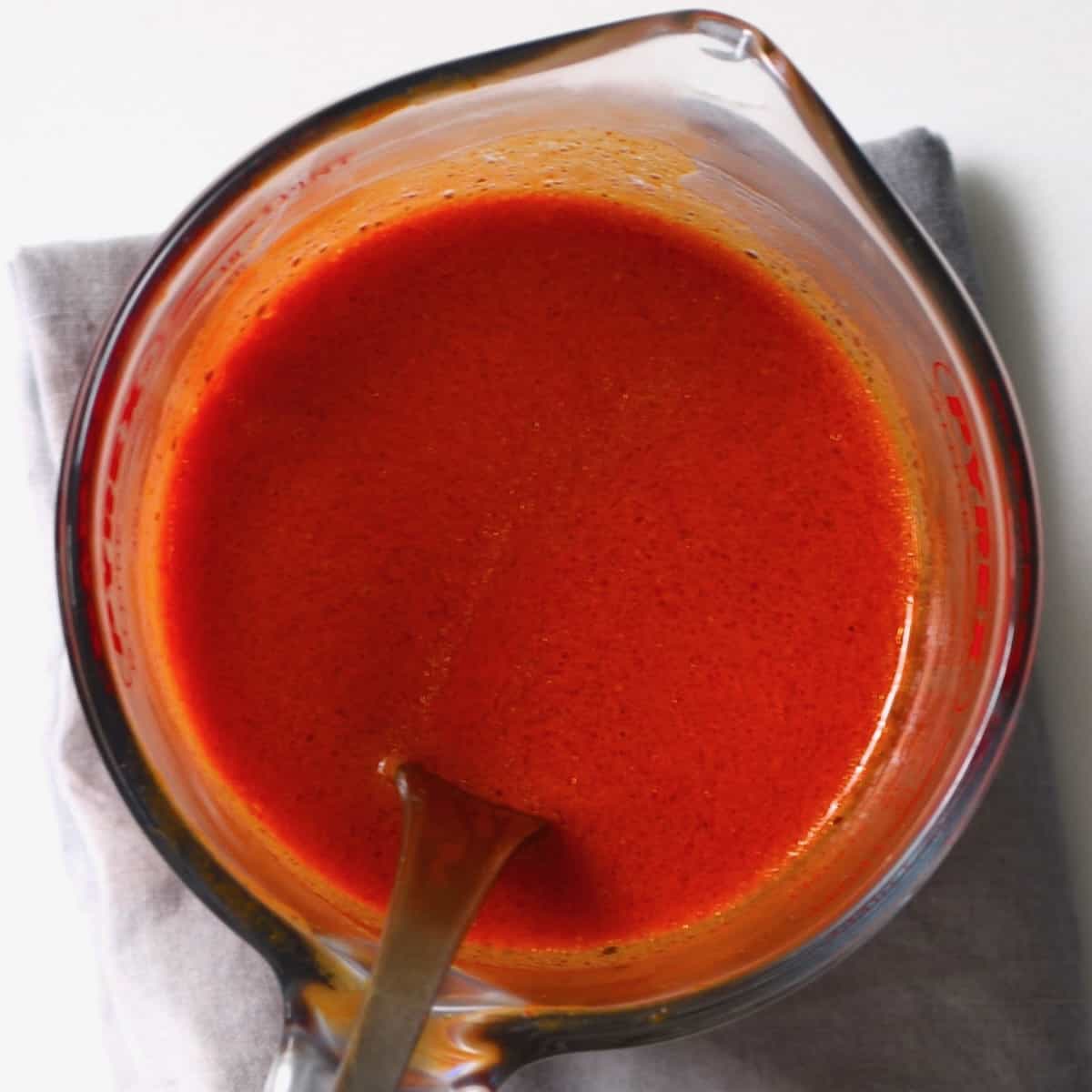
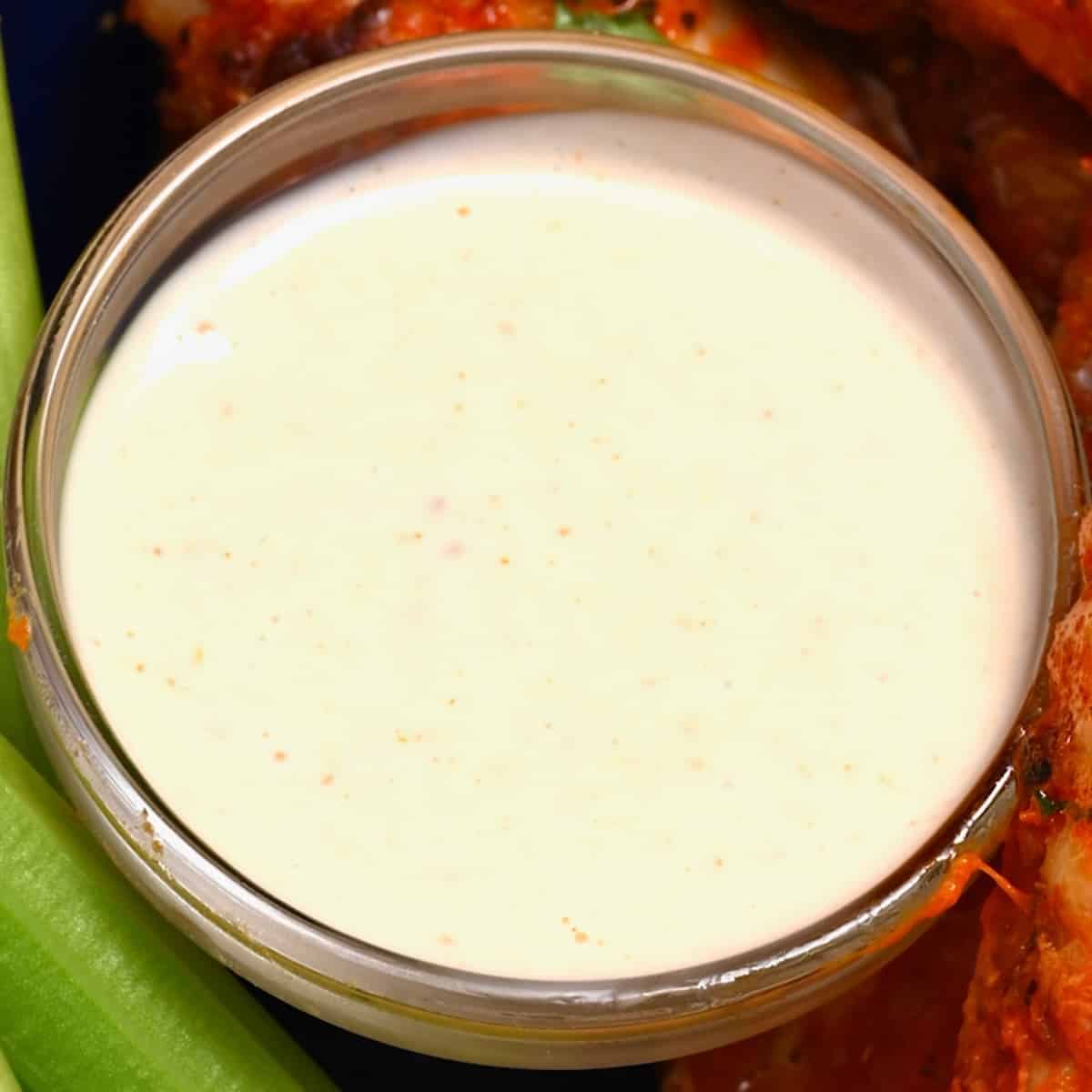
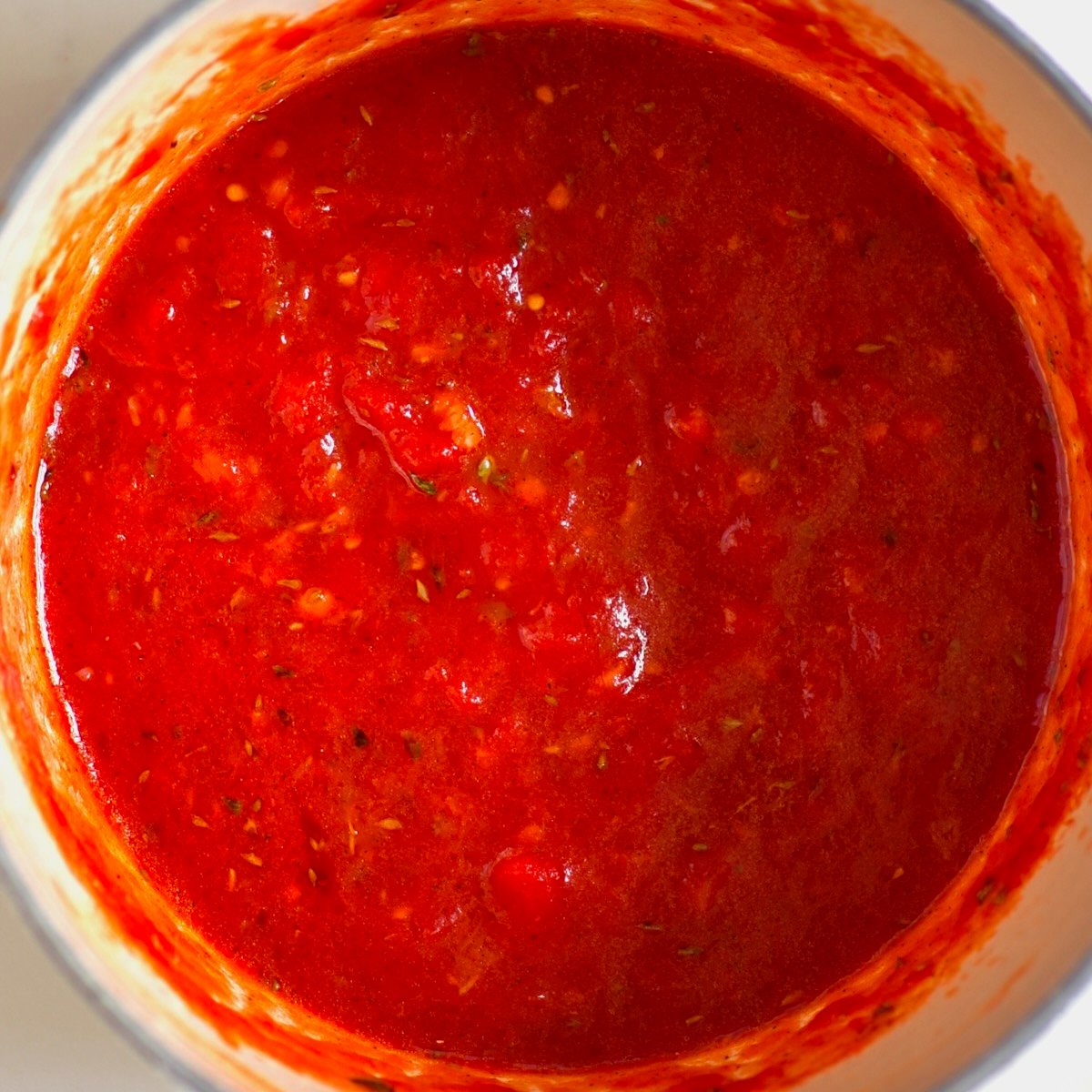
If you try this easy homemade brown gravy recipe, I’d love to hear your thoughts/questions below. Also, I’d appreciate a recipe card rating below, and feel free to tag me in your recipe recreations on Instagram @Alphafoodie!
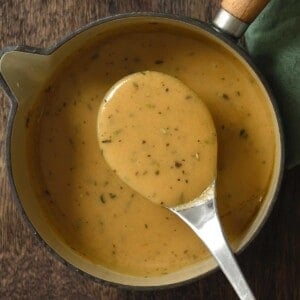
Easy Brown Gravy (With or Without Drippings)
Ingredients
- 1.58 oz butter 3 Tbsp; unsalted
- 0.84 oz flour 3 Tbsp
- 1.5 cups chicken or beef stock or use a combination of meat drippings and stock that reaches 1.5 cups
- 1 tsp Worcestershire sauce
- 1/2 tsp garlic powder
- 1/2 tsp onion powder
- 1/2 tsp salt or to taste (use less if chicken stock is salty)
- 1/4 tsp black pepper
- 1/4 tsp dried rosemary
- 1/4 tsp dried thyme
- 1/4 tsp dried basil or dried sage
Instructions
- Melt the butter in a saucepan over medium-low heat, being careful not to allow it to brown.
- Add the flour, whisking well to ensure there are no lumps. Cook it for 2-3 minutes, until it browns, then reduce the heat to low.
- Pour in the chicken stock (or beef stock) a small amount at a time, whisking constantly to ensure the roux remains smooth and lump-free. Allow the sauce to thicken slightly after each addition, then add more until you’ve used it all.If you want to use the meat drippings, add them now in place of some of the broth, and stir well.
- Add the Worcestershire sauce, whisking well. Then stir in the dried herbs and any salt if needed. Add the garlic powder, onion powder, and black pepper and whisk well (adjust the amounts to taste).
- Allow the sauce to simmer for a few more minutes to thicken and slightly reduce. Then remove from the heat and enjoy!
Storage Instructions
- Storing: Allow it to cool, and then store any leftovers in an airtight container in the fridge for 3-4 days. Freeze: You can freeze the beef gravy/ sauce in an airtight container, ice cube tray, or Ziplock bag for up to 6 months. However, I recommend using it within 3-4 months for the best flavor. Reheat: This homemade gravy will thicken as it chills in the refrigerator but becomes loose again once reheated. To do so, use a microwave or stovetop, whisking well until smooth and heated through. You may need an extra splash of water or stock to bring it back to the correct consistency.
Notes
- Whisk constantly: When dealing with a flour roux, the key to avoiding lumpy gravy/ sauce is to whisk constantly when adding the stock (a little at a time) to the roux.
- To use fresh herbs: Make sure to finely mince the herbs and adjust the amount accordingly. 1 teaspoon of dried herbs = 1 tablespoon of fresh herbs.
- Using drippings: I recommend always saving your droppings and freezing them until you’re ready to use them (for up to 6 months!). Then you can add them to this brown gravy recipe, reducing the broth amount accordingly.
- Swap out the broth: It’s really easy to adjust this recipe between homemade chicken gravy or beef gravy by simply swapping out the stock used (and drippings, if any). However, combining both could also make an all-purpose brown gravy recipe. Other stocks/drippings should also work, like turkey.
- Onion: Instead of using onion powder, sauté a yellow onion at the beginning before creating the roux.
- Mushrooms: To make a heartier gravy, sauté some mushroom slices until browned before creating the roux.
- Wine: I recommend using dry red wine when making brown beef gravy. For chicken gravy, I recommend a dry white wine (just a splash will do when adding the broth).
- Mustard: Use regular or Dijon mustard or some mustard powder to add a subtle depth of flavor. Start with ½ tsp and increase to taste.
- Bay leaf: Works really well with homemade beef gravy.
- Chicken or beef bouillon: Adding a small amount of bouillon powder can help to add a meatier depth. Decrease any added salt accordingly.
- Liquid smoke: Add just a few drops of liquid smoke for a subtle smoky depth.
- Kitchen bouquet: A few drops will make your brown gravy mix a richer brown.
Nutrition
Nutrition information is automatically calculated, so should only be used as an approximation.













